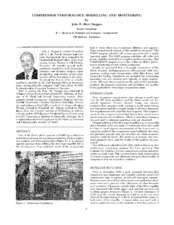| dc.contributor.other | Turbomachinery Symposium (16th : 1987) | |
| dc.creator | Duggan, John B. (Ben) | |
| dc.date.accessioned | 2017-10-05T14:30:29Z | |
| dc.date.available | 2017-10-05T14:30:29Z | |
| dc.date.issued | 1987 | |
| dc.identifier.uri | https://hdl.handle.net/1969.1/163610 | |
| dc.description | Lecture | en |
| dc.description | Pg. 9-22 | en |
| dc.description.abstract | One of Du Pont's plants operates a 20,000 hp synchronous motor driven process air compressor consisting offour compression sections and three intercoolers (Figure 1). A six percent capacity increase from refitting the first stage impeller led to the development of an analytical model of the compression train to study other ways to increase efficiency and capacity. Three computerized versions of this model are discussed. The POINT program calculates all system parameters for a single operating point. The MAP program calculates all outlet and power variables needed for a complete performance map. The
COMPARISON program is used for on-line or off-line performance monitoring of each system component. Results are presented from a thorough examination of the effects of speed, discharge pressure, inlet pressure, inlet temperature, cooling water temperature, inlet filter losses, and intercooler fouling. Guidelines are included for minimizing operating costs and meeting new capacity or range requirements. Although the numerical results apply to this particular machine, the general conclusions and guidelines are qualitatively applicable to other large compression trains. | en |
| dc.format.medium | Electronic | en |
| dc.format.mimetype | application/pdf | |
| dc.language.iso | en | |
| dc.publisher | Texas A&M University. Turbomachinery Laboratories | |
| dc.relation.ispartof | Proceedings of the 16th Turbomachinery Symposium | en |
| dc.subject.lcsh | Turbomachines | en |
| dc.title | Compressor Performance Modelling And Monitoring. | en |
| dc.type.genre | Presentation | en |
| dc.type.material | Text | en |
| dc.identifier.doi | https://doi.org/10.21423/R1237K | |


